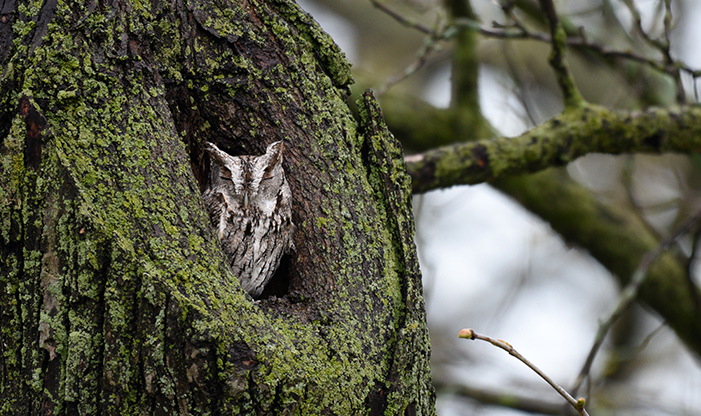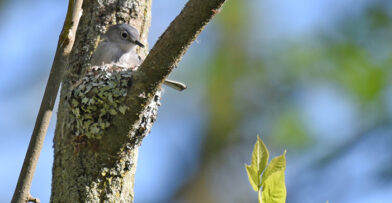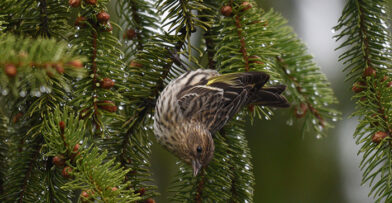Owls are some of the most beloved and fascinating birds in the raptor world, but spotting or hearing them can pose quite the challenge. These night hunters are designed for stealth, blending seamlessly into the trees as they remain still and silent waiting for the sun to set. While owls are known for their impressive hoots, their language consists of a range of calls, screeches, and whistles. The four most common owls in Wisconsin that are found year-round include the Northern Saw-whet, Eastern Screech, Barred, and Great Horned Owl.
Northern Saw-whet Owls
The Northern Saw-whet Owl is the smallest owl species in Wisconsin. Standing at only seven inches tall with a 17-inch wingspan, these tiny birds can easily conceal themselves perched in the dense coniferous trees. They have mottled brown bodies and white facial disks and eyebrows that connect in a ‘Y’ over their beaks, framing their oversized yellow eyes. Deer mice make up the majority of the Northern Saw-whet Owl’s diet, but they will prey upon other small rodents and insects when necessary. The best time of year to hear these owls calling to each other is during late winter and early spring on their northern breeding grounds. Their call is a distinctive too-too-too song which they whistle back to back at an even pitch.
Eastern Screech Owls
Eastern Screech Owls are another small owl species found in the state, averaging at eight inches tall with a 20-inch wingspan. An easily identifying feature is the feather tufts on top of their head. These prominent tufts can aid in camouflage, as their plumage resembles tree bark with complex banding and splotching. Screech Owls can either be mostly gray or a reddish-brown morph, but you are more likely to see the gray morph in this area of Wisconsin. They prefer mixed woodlands where they can perch in tree cavities and watch for large insects or small rodents to prey upon. The Eastern Screech Owl’s call sounds like a descending whinny followed by a short burst of even-pitched trills.
Barred Owls
You are most likely to spot a Barred Owl in trees near wetlands and rivers. They are adapted to hunting fish, amphibians, and invertebrates. When you’re hiking in these areas, keep your eyes peeled for a medium-sized owl, about 18 inches tall and boasting a wingspan of three to four feet. You’ll also see their heavily barred plumage, with gray and white stripes providing excellent camouflage with the deciduous and coniferous tree bark they nest in. You’ll want to keep your ears open, as Barred Owls have an extremely distinctive call. Their hoot sounds like the question “who cooks for you? Who cooks for you all?”
Great Horned Owls
The largest owl species regularly found in Wisconsin is also the most common: the Great Horned Owl. They can stand up to two feet tall, with distinct feather tufts on top of the head. Their soft, rounded wings can reach lengths of more than four feet, allowing them the strength to catch mammals ranging in size from voles to skunks and gophers. Their camouflage aids them in sneaking up on their prey, with sooty, mottled brown bodies, a reddish facial dish, and a white patch on the throat. As one of the biggest owl species wherever they live, they are not afraid to be vocal, sending out loud hoots.
While these owls are native year-round and relatively common, there are up to seven other species of owls in Wisconsin that could be spotted: Barn Owls, Northern Hawk Owls, Great Gray Owls, Long and Short-eared Owls – classified as birds of “special concern” by the Wisconsin DNR, Boreal Owls, and Snowy Owls. Of these, the Snowy Owl is the bird you’re most likely to see. They often migrate south to Wisconsin between November and March, and are utterly unmistakable, with stark white plumage and bright yellow eyes.
As you hike Wisconsin’s forests this fall in search of owls, you may be lucky enough to spot all four of the most common species found here. Owls are incredibly exciting to catch sight of, but it can be even more exhilarating to identify them by their hoots and calls.


